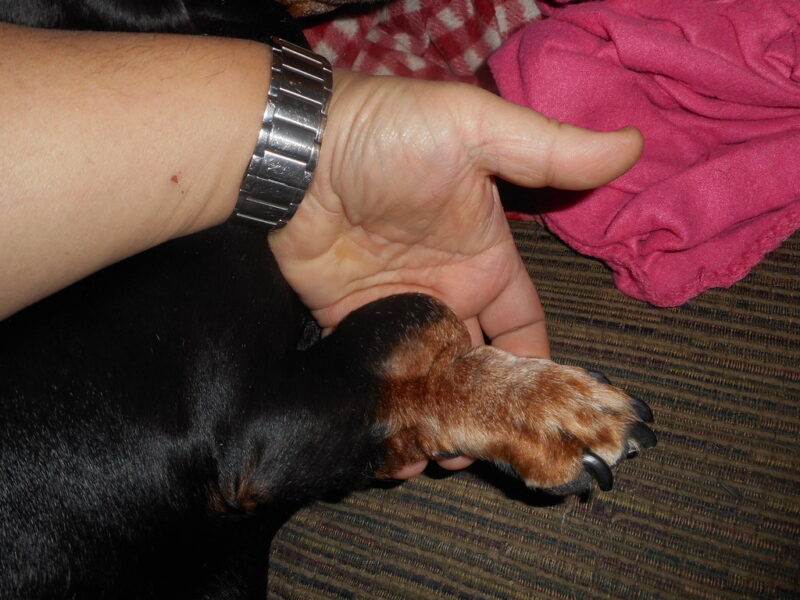Pet Wellness Guides > Should You Worry About That Lump on Your Dog? - Pet Insurance Review
Should You Worry About That Lump on Your Dog?
Posted: 10/28/2022 | BY: Jenna Bruce | Categories: Dog , Health problems , Pet care
You’ve discovered a weird lump on your dog. What is it exactly, and should you be worried?
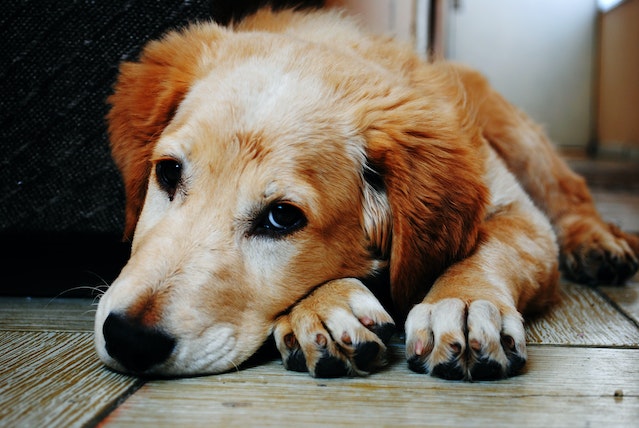
Many pet parents discover odd lumps and bumps on their fur babies, which can set their minds reeling and their hearts racing. Understand that not all lumps are cancerous. And certain types of lumps and bumps are harmless and more common than you think.
Common Lumps and Bumps on Dogs
Many of the following lumps and bumps are found on older dogs. But if you have a puppy, you should file this information away to keep an eye out as your fur baby ages. Some of the lumps on this list are non-cancerous, while some can be caused by infections and underlying conditions. Should you find a lump on your dog, it is always recommended you take your dog to the vet and get them looked at, just in case. Your vet will diagnose and determine a course of treatment if needed.
Lipomas
Tony Alter from flickr
Many older dogs develop fatty tumors that are called lipomas. These are typically soft and round lumps of fat located right underneath the skin. They are made up of only fat cells and are benign. While larger dog breeds are prone to lipomas, they can develop in smaller breeds as well. If you find any lumps that fit this description, bring your dog in to see your vet, who will use a fine needle to aspirate the lump and look at the cells under a microscope to ensure they are fat cells.
Sebaceous Cysts
These cysts are smaller than the lipomas and typically look like a pimple or a wart. Sebaceous cysts are formed when oil glands become blocked. They sometimes burst and release a pasty white substance.
These cysts are smaller than lipomas and typically look like pimples or warts. Sebaceous cysts are formed when oil glands become blocked. They sometimes burst and release a pasty white substance.
Breeds most prone to developing these cysts are those with fine hair, such as poodles and Bichon Frises. Often, these cysts will disappear on their own, though some dogs will have them for years. Be aware that if these cysts linger, they can become infected. Surgical removal is an option if your dog’s cysts are irritating them.
Warts
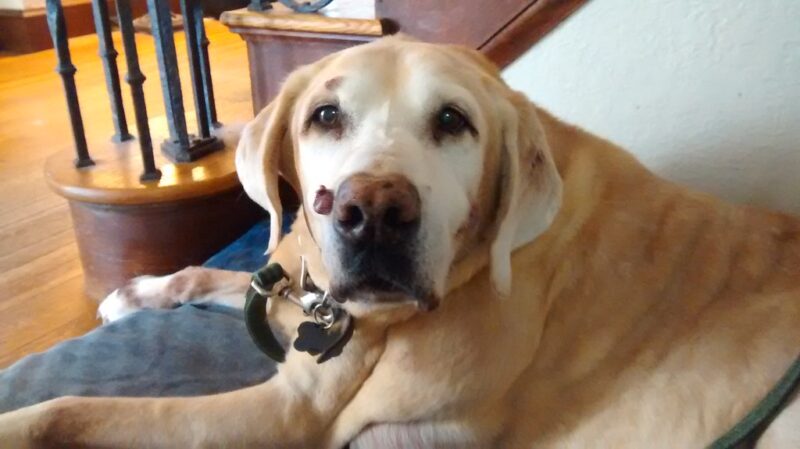
Lorraine DiSabato flickr
These warts are small and look like tiny cauliflower bumps. They are caused by the papillomavirus and most often occur in puppies without fully developed immune systems. Warts generally disappear on their own.
Skin Tags
Skin tags are small fibrous bumps that look like raised flaps of skin. They sometimes have hair growing on them. Skin tags are caused by overactive cells called fibroblasts and can occur in dogs of any breed or age. Skin tags are typically harmless, though most vets want to do a biopsy to be sure. Always consult your vet if your dog’s skin tags have changed in shape, color, or size.
Abscesses
Abscesses are areas of swollen tissue that are caused by an infection. It is common for dogs to develop abscesses around bug bites, animal bites, infected glands, and other types of wounds and sores. Abscesses should be treated early as they can grow and burst, which is painful for your pup. Vets usually prescribe antibiotics to treat the infection.
Button Tumors
These are also called histiocytomas, benign tumors affecting puppies and young dogs between eight weeks and three years of age. Button tumors are caused by an overproduction of immune cells and usually disappear on their own.
Mast Cell Tumors
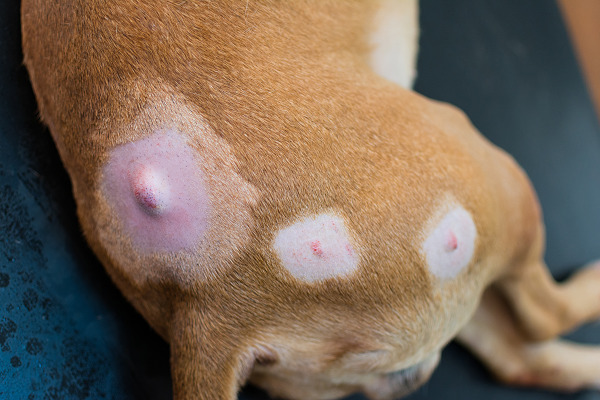
VCA Canada
These are cancerous tumors that can develop beneath or on top of the skin. Mast cell tumors are usually solid to the touch and irregular in shape. Should you find one of these on your dog, you should immediately make an appointment with your vet. Many vets opt to remove the tumor before performing a biopsy to determine if the cancer has spread. If surgical removal isn’t possible, your vet may refer you to an oncologist for chemotherapy or radiation treatment.
Pet Insurance Can Help with Unexpected Vet Bills
Finding a lump on your dog is always a scary event. Not only can it be emotional and stressful, but it can also be very costly. A pet insurance plan can help you pay for these unexpected expenses, sometimes reimbursing you for up to 90% of the vet bill. This gives you one less thing to worry about so you can focus your full attention on the best treatment options for your fur baby.
But don’t take our word for it. See what one pup owner had to say about how pet insurance helped her get a suspicious lump removed from her beloved French Bulldog:
Meet Izzy
“Izzy is our beloved four year old French Bulldog. One of the smartest decisions I made in terms of her care was to enroll her in Healthy Paws Pet Insurance. She is the love of our lives but has had some costly health issues, ranging from skin allergies, stomach problems and most recently, a lump on her paw that was quickly increasing in size. We were afraid of surgery (mostly because of the risks associated with anesthesia when administered to brachycephalic breeds) but decided to proceed with the surgery to remove the lump before it got bigger and in order to get it biopsied.
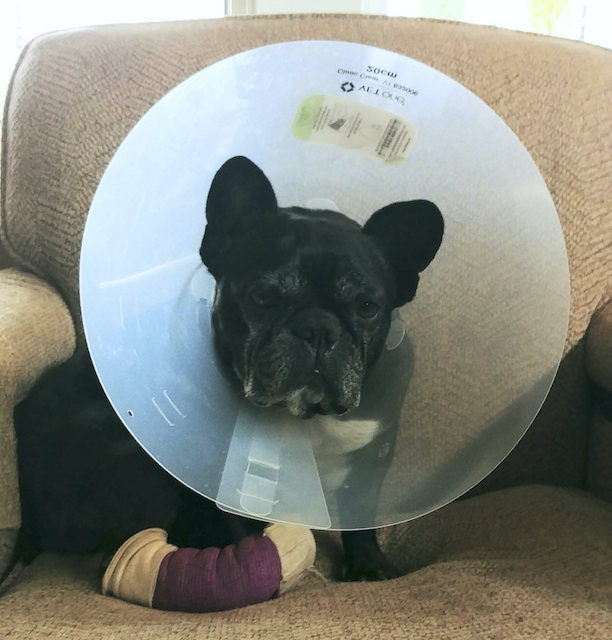
Izzy recovering from surgery
If we did not have pet insurance, we would not have been able to afford this procedure. We would have been waiting and worrying whether the lump was benign or not (fortunately it turned out to be cancer-free).
In addition to being reimbursed for a huge percentage of Izzy’s expenses, Healthy Paws has consistently provided the kindest and friendliest customer service. We received our reimbursement check for the surgery in less than a week after I filed the claim- amazing! We adopted another puppy over the summer and she is now covered as well. I wish my OWN healthcare coverage was as awesome as Healthy Paws!” – Madeleine (9/20/22)
Get a free insurance quote today… for your pups’ health and your peace of mind.
References:
Manucy, T., DVM., ( 2022) “Lumps, Bumps, and Cysts on Dogs.” Retrieved from: https://www.petmd.com/dog/symptoms/lumps-bumps-and-cysts-dogs
Bauhaus, J., (2021) “Dog Skin Lumps & Bumps: When You Should Worry.” Retrieved from: https://www.akc.org/expert-advice/health/dog-skin-lumps-bumps-when-you-should-worry/
Esposito, D., (2021) “Common Bumps On Dogs’ Skin And What They Mean.” Retrieved from: https://www.thedodo.com/dodowell/bumps-on-dogs-skin
Disclaimer
The information contained on this blog is intended for informational and educational purposes only and should not be construed as medical advice. It is not a substitute for professional veterinary care. Always consult with your veterinarian before making any changes to your pet's health care or treatment plan.
The authors of this blog are not veterinarians and do not claim to be experts in pet health. The information provided here is based on our own experiences and research, as well as information from reputable sources. However, we cannot guarantee the accuracy or completeness of this information.
We encourage you to do your own research and consult with your veterinarian before making any decisions about your pet's health.
